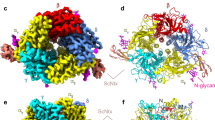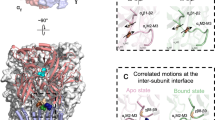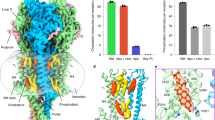Abstract
Acetylcholine receptors of fish electric organs and mammalian skeletal muscle comprise four structurally homologous glycoprotein subunits in the mole ratio α2βγδ (refs 1–4). All four subunits have leader sequences and are exposed on both sides of the membrane5,6. From amino acid sequencing, three groups5,7,8 have predicted that each subunit has four hydrophobic α-helical transmembranous domains. Because the N-terminus of each subunit is thought to remain on the extracellular surface after cleavage of the leader sequence, this model predicts that the N- and C-termini are both on the extracellular side. An alternative model proposed by two other groups9,10 predicts that there is, in addition, a fifth amphipathic transmembranous domain which would place the C-terminus on the cytoplasmic side. Here, using anti-subunit sera and monoclonal antibodies and their reaction with synthetic subunit peptides, we demonstrate that the C-terminus is in fact on the cytoplasmic surface. We also show that, contrary to other predictions11, the most hydrophilic sequence on the extracellular domain of α-subunits is not the main immunogenic region.
This is a preview of subscription content, access via your institution
Access options
Subscribe to this journal
Receive 51 print issues and online access
$199.00 per year
only $3.90 per issue
Buy this article
- Purchase on Springer Link
- Instant access to full article PDF
Prices may be subject to local taxes which are calculated during checkout
Similar content being viewed by others
References
Lindstrom, J., Merlie, J. & Yogeeswaran, G. Biochemistry 18, 4465–4470 (1979).
Reynolds, J. A. & Karlin, A. Biochemistry 17, 2035–2038 (1978).
Raftery, M., Hunkapiller, M., Strader, C. & Hood, L. Science 208, 1454–1457 (1980).
Conti-Tronconi, B., Hunkapiller, M., Lindstrom, J. & Raftery, M. Proc. natn. Acad. Sci. U.S.A. 79, 6489–6493 (1982).
Noda, M. et al. Nature 302, 528–532 (1983).
Anderson, D. & Blobel, G. Proc. natn. Acad. Sci. U.S.A. 78, 5598–5602 (1981).
Claudio, T., Ballivet, M., Patrick, J. & Heinemann, S. Proc. natn. Acad. Sci. U.S.A. 80, 1111–1115 (1983).
Devillers-Thiery, A., Giraudat, J., Bentaboulet, M. & Changeux, J. P. Proc. natn. Acad. Sci. U.S.A. 80, 2067–2071 (1983).
Guy, R. Biophys. J. 45, 249–261 (1983).
Finer-Moore, J. & Stroud, R. Proc. natn. Acad. Sci. U.S.A. 81, 155–159 (1984).
Noda, M. et al. Nature 299, 793–797 (1982).
Tzartos, S. & Lindstrom, J. Proc. natn. Acad. Sci. U.S.A. 77, 755–759 (1980).
Tzartos, S., Rand, D., Einarson, B. & Lindstrom, J. J. Biol. Chem. 256, 8635–8645 (1981).
Tzartos, S., Langeberg, L., Hochschwender, S. & Lindstrom, J. FEBS Lett. 158, 116–118 (1983).
Hopp, T. & Woods, K. Proc. natn. Acad. Sci. U.S.A. 78, 3824–3828 (1981).
Sargent, P., Hedges, B., Tsavaler, L., Clemmons, L., Tzartos, S. & Lindstrom, J. J. Cell Biol. 98, 609–618 (1983).
Swanson, L. et al. Proc. natn. Acad. Sci. U.S.A. 80, 4532–4536 (1983).
Gullick, W. & Lindstrom, J. Biochemistry 22, 3801–3807 (1983).
Elliott, J. et al. Biochem. J. 185, 667–678 (1980).
Froehner, S., Douville, K., Klink, S. & Culp, W. J. Biol. Chem. 258, 7112–7120 (1983).
Burden, S., DePalma, R. & Gottesman, G. Cell 35, 687–692 (1983).
Ratnam, M. & Lindstrom, J. Biochem. biophys. Res. Commun. 122, 1225–1233 (1984).
Lewis, C. & Stevens, C. Proc. natn. Acad. Sci. U.S.A. 80, 6110–6113 (1983).
Juillerat, M., Barkas, T. & Tzartos, S. FEBS Lett. 168, 143–148 (1984).
Merlie, J. P. & Lindstrom, J. Cell 34, 747–757 (1983).
Lanier, L. L., Gutman, G. A., Lewis, D. E., Griswold, S. T. & Warner, N. L. Hybridoma 1, 125–131 (1982).
Johnson, R. & Nakamura, R. in Immunoassays: Clinical Laboratory Techniques for the 1980s 141–156 (Liss, New York, 1980).
Friguet, B., Djavadi-Ohaniance, L., Pages, J., Bussard, A. & Goldberg, M. J. immun. Meth. 60, 351–358 (1983).
Neubig, R., Krodel, E., Boyd, N. & Cohen, J. Proc. natn. Acad. Sci. U.S.A. 76, 690–694 (1979).
Lindstrom, J., Einarson, B. & Tzartos, S. Meth. Enzym. immunochem. Tech. 74, 432–460 (1981).
Author information
Authors and Affiliations
Rights and permissions
About this article
Cite this article
Lindstrom, J., Criado, M., Hochschwender, S. et al. Immunochemical tests of acetylcholine receptor subunit models. Nature 311, 573–575 (1984). https://doi.org/10.1038/311573a0
Received:
Accepted:
Issue Date:
DOI: https://doi.org/10.1038/311573a0
This article is cited by
-
Molecular studies of the neuronal nicotinic acetylcholine receptor family
Molecular Neurobiology (1987)
Comments
By submitting a comment you agree to abide by our Terms and Community Guidelines. If you find something abusive or that does not comply with our terms or guidelines please flag it as inappropriate.



